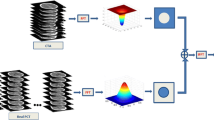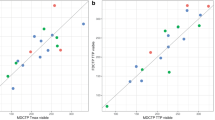Abstract
Purpose
To explore the feasibility of using correlation-based time-delay (CTD) maps produced from time-resolved MR angiography (TRMRA) to diagnose perfusion abnormalities in patients suspected to have steno-occlusive lesions in the craniocervical arteries.
Materials and methods
Twenty-seven patients who were suspected to have steno-occlusive lesions in the craniocervical arteries underwent both TRMRA and brain single-photon emission computed tomography (SPECT). TRMRA was performed on the supra-aortic area after intravenous injection of a 0.03 mmol/kg gadolinium-based contrast agent. Time-to-peak (TTP) maps and CTD maps of the brain were automatically generated from TRMRA data, and their quality was assessed. Detection of perfusion abnormalities was compared between CTD maps and the time-series maximal intensity projection (MIP) images from TRMRA and TTP maps. Correlation coefficients between quantitative changes in SPECT and parametric maps for the abnormal perfusion areas were calculated.
Results
The CTD maps were of significantly superior quality than TTP maps (p < 0.01). For perfusion abnormality detection, CTD maps (kappa 0.84, 95% confidence interval [CI] 0.67-1.00) showed better agreement with SPECT than TTP maps (0.66, 0.46-0.85). For perfusion deficit detection, CTD maps showed higher accuracy (85.2%, 95% CI 66.3-95.8) than MIP images (66.7%, 46-83.5), with marginal significance (p = 0.07). In abnormal perfusion areas, correlation coefficients between SPECT and CTD (r = 0.74, 95% CI 0.34-0.91) were higher than those between SPECT and TTP (r = 0.66, 0.20-0.88).
Conclusion
CTD maps generated from TRMRA were of high quality and offered good diagnostic performance for detecting perfusion abnormalities associated with steno-occlusive arterial lesions in the craniocervical area.
Key Points
• Generation of perfusion parametric maps from time-resolved MR angiography is clinically useful.
• Correlation-based delay maps can be used to detect perfusion abnormalities associated with steno-occlusive craniocervical arteries.
• Estimation of correlation-based delay is robust for low signal-to-noise 4D MR data.





Similar content being viewed by others
Abbreviations
- ASPECT:
-
Alberta Stroke Program Early CT score
- CI:
-
Confidence interval
- CTD:
-
Correlation-based time delay
- DSA:
-
Digital subtraction cerebral angiography
- GBCA:
-
Gadolinium-based contrast agent
- HR-CEMRA:
-
High-resolution contrast-enhanced MR angiography
- ICA:
-
Internal carotid artery
- ICC:
-
Intra-class coefficients
- IQR:
-
Interquartile range
- MCA:
-
Middle cerebral artery
- MIP:
-
Maximal intensity projection
- ROI:
-
Region of interest
- SNR:
-
Signal-to-noise ratio
- TRMRA:
-
Time-resolved, multiphasic MR angiography
- TTP:
-
Time to peak
- TWIST:
-
Time-resolved angiography with stochastic trajectories
References
Haider CR, Hu HH, Campeau NG, Huston J 3rd, Riederer SJ (2008) 3D high temporal and spatial resolution contrast-enhanced MR angiography of the whole brain. Magn Reson Med 60:749–760
Forkert ND, Illies T, Moller D, Handels H, Saring D, Fiehler J (2012) Analysis of the influence of 4D MR angiography temporal resolution on time-to-peak estimation error for different cerebral vessel structures. AJNR Am J Neuroradiol 33:2103–2109
Lim RP, Shapiro M, Wang EY et al (2008) 3D time-resolved MR angiography (MRA) of the carotid arteries with time-resolved imaging with stochastic trajectories: comparison with 3D contrast-enhanced Bolus-Chase MRA and 3D time-of-flight MRA. AJNR Am J Neuroradiol 29:1847–1854
Chimowitz MI, Lynn MJ, Howlett-Smith H et al (2005) Comparison of warfarin and aspirin for symptomatic intracranial arterial stenosis. N Engl J Med 352:1305–1316
Derdeyn CP, Grubb RL Jr, Powers WJ (1999) Cerebral hemodynamic impairment: methods of measurement and association with stroke risk. Neurology 53:251–259
Machet A, Portefaix C, Kadziolka K, Robin G, Lanoix O, Pierot L (2012) Brain arteriovenous malformation diagnosis: value of time-resolved contrast-enhanced MR angiography at 3.0T compared to DSA. Neuroradiology 54:1099–1108
Nael K, Meshksar A, Ellingson B et al (2014) Combined low-dose contrast-enhanced MR angiography and perfusion for acute ischemic stroke at 3T: A more efficient stroke protocol. AJNR Am J Neuroradiol 35:1078–1084
Rothwell PM, Gibson RJ, Slattery J, Warlow CP (1994) Prognostic value and reproducibility of measurements of carotid stenosis. A comparison of three methods on 1001 angiograms. European Carotid Surgery Trialists' Collaborative Group. Stroke 25:2440–2444
Kinner S, Eggebrecht H, Maderwald S et al (2015) Dynamic MR angiography in acute aortic dissection. J Magn Reson Imaging 42:505–514
Farb RI, Agid R, Willinsky RA, Johnstone DM, Terbrugge KG (2009) Cranial dural arteriovenous fistula: diagnosis and classification with time-resolved MR angiography at 3T. AJNR Am J Neuroradiol 30:1546–1551
Taschner CA, Gieseke J, Le Thuc V et al (2008) Intracranial arteriovenous malformation: time-resolved contrast-enhanced MR angiography with combination of parallel imaging, keyhole acquisition, and k-space sampling techniques at 1.5 T. Radiology 246:871–879
Zou Z, Ma L, Cheng L, Cai Y, Meng X (2008) Time-resolved contrast-enhanced MR angiography of intracranial lesions. J Magn Reson Imaging 27:692–699
Raoult H, Bannier E, Maurel P et al (2014) Hemodynamic quantification in brain arteriovenous malformations with time-resolved spin-labeled magnetic resonance angiography. Stroke 45:2461–2464
Illies T, Forkert ND, Saering D et al (2012) Persistent hemodynamic changes in ruptured brain arteriovenous malformations. Stroke 43:2910–2915
Seeger A, Klose U, Poli S, Kramer U, Ernemann U, Hauser TK (2015) Acute stroke imaging: feasibility and value of MR angiography with high spatial and temporal resolution for vessel assessment and perfusion analysis in patients with wake-up stroke. Acad Radiol 22:413–422
Lv Y, Margulies DS, Cameron Craddock R et al (2013) Identifying the perfusion deficit in acute stroke with resting-state functional magnetic resonance imaging. Ann Neurol 73:136–140
Amemiya S, Kunimatsu A, Saito N, Ohtomo K (2014) Cerebral hemodynamic impairment: assessment with resting-state functional MR imaging. Radiology 270:548–555
Lee YJ, Kim BS, Koo JS et al (2015) Supra-aortic low-dose contrast-enhanced time-resolved magnetic resonance (MR) angiography at 3 T: comparison with time-of-flight MR angiography and high-resolution contrast-enhanced MR angiography. Acta Radiol 56:673–680
Lee YJ, Laub G, Jung SL et al (2011) Low-dose 3D time-resolved magnetic resonance angiography (MRA) of the supraaortic arteries: correlation with high spatial resolution 3D contrast-enhanced MRA. J Magn Reson Imaging 33:71–76
NamY, Jang J, Lee S, Kim B, AhnMI (2016) Automated extraction of arterial and venous function from time-resolved multiphasic MR angiography. Proc Int Soc Magn Reson Med Sci Meet Exhib Int Soc Magn Reson Med Sci Meet Exhib:1423
Samuels OB, Joseph GJ, Lynn MJ, Smith HA, Chimowitz MI (2000) A standardized method for measuring intracranial arterial stenosis. AJNR Am J Neuroradiol 21:643–646
Pexman JH, Barber PA, Hill MD et al (2001) Use of the Alberta Stroke Program Early CT Score (ASPECTS) for assessing CT scans in patients with acute stroke. AJNR Am J Neuroradiol 22:1534–1542
Moneta GL, Edwards JM, Chitwood RW et al (1993) Correlation of North American Symptomatic Carotid Endarterectomy Trial (NASCET) angiographic definition of 70% to 99% internal carotid artery stenosis with duplex scanning. J Vasc Surg 17:152–157 discussion 157-159
Jenkinson M, Bannister P, Brady M, Smith S (2002) Improved optimization for the robust and accurate linear registration and motion correction of brain images. Neuroimage 17:825–841
Landis JR, Koch GG (1977) An application of hierarchical kappa-type statistics in the assessment of majority agreement among multiple observers. Biometrics 33:363–374
Forkert ND, Fiehler J, Ries T et al (2011) Reference-based linear curve fitting for bolus arrival time estimation in 4D MRA and MR perfusion-weighted image sequences. Magn Reson Med 65:289–294
Shpilfoygel SD, Close RA, Valentino DJ, Duckwiler GR (2000) X-ray videodensitometric methods for blood flow and velocity measurement: a critical review of literature. Med Phys 27:2008–2023
Ostergaard L (2005) Principles of cerebral perfusion imaging by bolus tracking. J Magn Reson Imaging 22:710–717
Grandin CB, Duprez TP, Smith AM et al (2002) Which MR-derived perfusion parameters are the best predictors of infarct growth in hyperacute stroke? Comparative study between relative and quantitative measurements. Radiology 223:361–370
Imamura T, Nagasawa H, Itoh M, Tsuburaya K (1996) The peak time difference of time-density curve in intravenous digital subtraction angiography correlates to an asymmetric cerebral blood flow as determined by positron emission tomography. Eur J Neurol 3:227–231
Kudo K, Sasaki M, Yamada K et al (2010) Differences in CT perfusion maps generated by different commercial software: quantitative analysis by using identical source data of acute stroke patients. Radiology 254:200–209
Kudo K, Christensen S, Sasaki M et al (2013) Accuracy and reliability assessment of CT and MR perfusion analysis software using a digital phantom. Radiology 267:201–211
Christen T, Jahanian H, Ni WW, Qiu D, Moseley ME, Zaharchuk G (2015) Noncontrast mapping of arterial delay and functional connectivity using resting-state functional MRI: a study in Moyamoya patients. J Magn Reson Imaging 41:424–430
Lee DK, Kim JS, Kwon SU, Yoo SH, Kang DW (2005) Lesion patterns and stroke mechanism in atherosclerotic middle cerebral artery disease: early diffusion-weighted imaging study. Stroke 36:2583–2588
Radbruch A, Weberling LD, Kieslich PJ et al (2015) Gadolinium retention in the dentate nucleus and globus pallidus is dependent on the class of contrast agent. Radiology 275:783–791
Funding
This research was supported by Basic Science Research Program through the National Research Foundation of Korea (NRF) funded by the Ministry of Education (NRF-2017R1D1A1B03033829).
Author information
Authors and Affiliations
Corresponding author
Ethics declarations
Guarantor
The scientific guarantor of this publication is Bum-soo Kim.
Conflict of interest
The authors of this manuscript declare no relationships with any companies, whose products or services may be related to the subject matter of the article.
Statistics and biometry
No complex statistical methods were necessary for this paper.
Informed consent
Written informed consent was waived by the Institutional Review Board.
Ethical approval
Institutional Review Board approval was obtained.
Methodology
• retrospective
• cross-sectional study
• performed at one institution
Electronic supplementary material
ESM 1
(DOCX 37.6 kb)
Rights and permissions
About this article
Cite this article
Nam, Y., Jang, J., Park, S.Y. et al. Correlation-based perfusion mapping using time-resolved MR angiography: A feasibility study for patients with suspicions of steno-occlusive craniocervical arteries. Eur Radiol 28, 4890–4899 (2018). https://doi.org/10.1007/s00330-018-5468-1
Received:
Revised:
Accepted:
Published:
Issue Date:
DOI: https://doi.org/10.1007/s00330-018-5468-1




